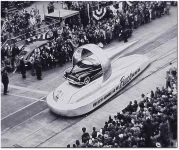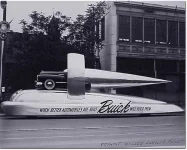-
This section is for help and assistance with 2018 and NEWER Buick Regals. If you need assistance with a 2011-2017 Buick Regal, CLICK HERE. If you need assistance with a 2010 or older Buick Regal, CLICK HERE. This notice may be dismissed by clicking the X in the right corner.
-

- Buick Forums
- Past Buick Vehicle Discussion
- Buick Regal Forums
- 2018+ Buick Regal Sportback and TourX Forum
You are using an out of date browser. It may not display this or other websites correctly.
You should upgrade or use an alternative browser.
You should upgrade or use an alternative browser.
CAR completely DEAD ?
- Thread author mjoshi
- Start date
Hunter Mike
Well-known member
- Joined
- Aug 8, 2019
- Messages
- 485
- Reaction score
- 369
- Points
- 63
- Location
- America’s Dairyland
- Buick Ownership
- Dark Moon 19 Buick Opel Vauxhall Insignia Country Tourer Regal TourX Essence Estate Avant Wagon
One of the issues with a modern car is that the voltage regulator moderates the output of the alternator to improve fuel efficiency. Steady-state driving with a fully charged battery will show 12.6-13.2v on the display. This isnt enough to charge the battery but reduces parasitic draw. It takes several horsepower to run the alternator so if the car companies can improve their CAFE by 0.1mpg they do it. They don’t care about your battery life, they care about hitting a target mpg and the exec‘s get their bonuses. Why are Toyota’s using 0w-16 oils? It’s not for longevity!
during deceleration the DIC will jump to over 15v because this is ”free” kinetic energy turned into heat and electricity.
Remember that any lead acid battery likes to be fully charged and cool. Any deviation from this shortens it’s life.
I’ve mentioned before, if you’re not driving your car, it needs to be a AGM specific charger that will top it off to 14.7v and feed it a constant voltage over 13v forever. NOCO & CTEK don’t do this. Deltran chargers do, commonly sold under Battery Tender. Less than $50 will help your battery last for up to a decade. Not uncommon. Motorcycle batteries have notoriety for being short-lived but my oldest is 9 years old and still acts perfect. It sits for 6+ months of the year in the basement on a Battery Tender Jr. Another is difficult to remove so it stays in the garage during the winter. No issues.
After purchase of my TourX I had a 1.5hr highway drive home in which the ASS never functioned. I knew it sat On the lot so I hooked up a 3.5A charger. The next morning it was still charging! I thought something was wrong with the charger so I tried another. It sucked 3A for many more hours until showing full. It was thirsty!
during deceleration the DIC will jump to over 15v because this is ”free” kinetic energy turned into heat and electricity.
Remember that any lead acid battery likes to be fully charged and cool. Any deviation from this shortens it’s life.
I’ve mentioned before, if you’re not driving your car, it needs to be a AGM specific charger that will top it off to 14.7v and feed it a constant voltage over 13v forever. NOCO & CTEK don’t do this. Deltran chargers do, commonly sold under Battery Tender. Less than $50 will help your battery last for up to a decade. Not uncommon. Motorcycle batteries have notoriety for being short-lived but my oldest is 9 years old and still acts perfect. It sits for 6+ months of the year in the basement on a Battery Tender Jr. Another is difficult to remove so it stays in the garage during the winter. No issues.
After purchase of my TourX I had a 1.5hr highway drive home in which the ASS never functioned. I knew it sat On the lot so I hooked up a 3.5A charger. The next morning it was still charging! I thought something was wrong with the charger so I tried another. It sucked 3A for many more hours until showing full. It was thirsty!
Last edited:
Anaduff
Associate Member
- Joined
- Nov 8, 2018
- Messages
- 1,002
- Reaction score
- 865
- Points
- 113
- Location
- St. Paul, Minnesota
- Buick Ownership
- 2019 Insignia GS, 2003 Jaguar X-Type
My CTEK Multi 3300 (3.3 amp max output) is designed for AGM & per your experience, after it was attached for the first time it took several days at full output before it dropped into maintenance mode. Even now, after a few days, it will go back to full charge for 30 min. or so, and likewise if you open any door on the car. I guess the expression 'use it or loose it' applies to batteries as well.
Silverarrow
Active member
- Joined
- Jan 9, 2020
- Messages
- 102
- Reaction score
- 126
- Points
- 43
- Buick Ownership
- 1963 Riviera, 2020 TourX Essence
Last edited:
2007LucerneCXL
Full Member
- Joined
- Jun 19, 2015
- Messages
- 12,835
- Reaction score
- 4,789
- Points
- 113
- Location
- Illinois
- Buick Ownership
- 2007 Lucerne CXL. and 1995 Lesabre currently, past 1973 Riviera, 1968 Riviera
Hunter Mike
Well-known member
- Joined
- Aug 8, 2019
- Messages
- 485
- Reaction score
- 369
- Points
- 63
- Location
- America’s Dairyland
- Buick Ownership
- Dark Moon 19 Buick Opel Vauxhall Insignia Country Tourer Regal TourX Essence Estate Avant Wagon
As an experiment, since I have time, I used lights and accessories to run the battery down last night. From fully charged I ran it down to 11.5V which is approximately 20% state of charge. It took a little over an hour in service mode with headlight, fogs, radio, HVAC. At 12V the DIC reported “battery saver” and turned the fan down to low. 10.5V is a “dead” battery for reference.
i put it on a 4A charger overnight and it was still charging at the absorption rate at 7:30 this morning after walking the dog. So 12ish hours of charging at 4A is 48 ah. Our battery has a 80AH rating.
If you believe that driving will charge your battery you are wrong. It would have taken an hour to charge my battery IF the alternator put out 50A. Our cars won’t do that because of the drag on the engine would kill the fuel economy.
i put it on a 4A charger overnight and it was still charging at the absorption rate at 7:30 this morning after walking the dog. So 12ish hours of charging at 4A is 48 ah. Our battery has a 80AH rating.
If you believe that driving will charge your battery you are wrong. It would have taken an hour to charge my battery IF the alternator put out 50A. Our cars won’t do that because of the drag on the engine would kill the fuel economy.
Wlepse
SUPER STAR!
- Joined
- Mar 18, 2019
- Messages
- 1,793
- Reaction score
- 883
- Points
- 113
- Location
- NNJ
- Buick Ownership
- 2018 Regal TourX Essence
Well I am not sure why you are so sure the car wouldn't output that much current to try to recover from a low voltage situation, they certainly have specs that indicate it can output much more. So if they are going to limit the output so much they might as well save money and space and go with a smaller unit.
But even if we accept that the stock alternator will never put out even half of the rated amp capacity, it still should be able to maintain a battery once it is back at normal voltage. Mine can't manage that; even after a new battery was installed the ASS functionality lasted only a day or so. This is the only vehicle I have ever had, including better cars in college that couldn't maintain enough battery to reliably start after sitting for more than a week.
But even if we accept that the stock alternator will never put out even half of the rated amp capacity, it still should be able to maintain a battery once it is back at normal voltage. Mine can't manage that; even after a new battery was installed the ASS functionality lasted only a day or so. This is the only vehicle I have ever had, including better cars in college that couldn't maintain enough battery to reliably start after sitting for more than a week.
Hunter Mike
Well-known member
- Joined
- Aug 8, 2019
- Messages
- 485
- Reaction score
- 369
- Points
- 63
- Location
- America’s Dairyland
- Buick Ownership
- Dark Moon 19 Buick Opel Vauxhall Insignia Country Tourer Regal TourX Essence Estate Avant Wagon
Then you better go back to your “better” cars. Welcome to the future.
Wlepse
SUPER STAR!
- Joined
- Mar 18, 2019
- Messages
- 1,793
- Reaction score
- 883
- Points
- 113
- Location
- NNJ
- Buick Ownership
- 2018 Regal TourX Essence
This has nothing to do with the future...we have several new vehicles in the family and none have issues like this. There have been several people on this forum that have had random electrical issues and it is likely that something is amiss in mine and several other people's cars if they can't keep a charge.Then you better go back to your “better” cars. Welcome to the future.
But back to your original statement; I get that the alternator may be "tuned" to do the bare minimum to maintain the battery, but what info do you have that says it will never be able to charge the battery? It just doesn't make sense they would have an alternator rated for 150A and not use even a third of the rated capacity. I would even concede that it may try to slowly build the charge level back up, but my commute is an hour each way, the performance doesn't change. Surely at some point it would have caught up. It also isn't consistent. I have at times gone over a week with no issues and I think the shortest period to a no start condition was 5 days. It is likely the dealer will end up putting another new battery in but I don't think this is going to fix the problem, I suspect there is some module that isn't going to sleep. Someone posted resting amp draw, if I get a chance I will check this out and report back, but it may help if others do the same so we can get an idea what is really normal. Or if someone has this info from GM that would be great.
PrincipalDan
SUPER STAR!
- Joined
- Jul 2, 2019
- Messages
- 1,312
- Reaction score
- 1,178
- Points
- 113
- Location
- Gallup, NM
- Buick Ownership
- 2018 Regal TourX
I wonder if there is a fault somewhere in one of the BCM (Body Control Modules)? Essentially causing a wiring fault that is draining things.
Wlepse
SUPER STAR!
- Joined
- Mar 18, 2019
- Messages
- 1,793
- Reaction score
- 883
- Points
- 113
- Location
- NNJ
- Buick Ownership
- 2018 Regal TourX Essence
I wouldn't be surprised if there was a bad batch of BCM's or perhaps it is something like the one person here that had a wiring harness compromised by a screw. All I know is it isn't the battery; when I bough the car the ASS functioned and then went away. I didn't care until the car didn't start. Replacement battery fixed ASS for a day or so then back to non-functional. So I think it is highly doubtful this is purely a battery issue.
PrincipalDan
SUPER STAR!
- Joined
- Jul 2, 2019
- Messages
- 1,312
- Reaction score
- 1,178
- Points
- 113
- Location
- Gallup, NM
- Buick Ownership
- 2018 Regal TourX
When Sergio Marchionne was still alive he berated FCA engineers for having more BCMs per platform than most of the industry. He saw them as failure points and ones that were difficult to diagnose when there was a problem. (Just FWIW)I wouldn't be surprised if there was a bad batch of BCM's or perhaps it is something like the one person here that had a wiring harness compromised by a screw. All I know is it isn't the battery; when I bough the car the ASS functioned and then went away. I didn't care until the car didn't start. Replacement battery fixed ASS for a day or so then back to non-functional. So I think it is highly doubtful this is purely a battery issue.
GermyShoe
Active member
- Joined
- Jul 15, 2019
- Messages
- 421
- Reaction score
- 172
- Points
- 43
- Location
- Richardson, TX
- Buick Ownership
- Regal TourX
I have a 2018 red needle that I bought in July of 2019 (had been on the lot for almost 18 months with < 100 miles). I have never had a problem with my battery and right now, I am only driving like every 3rd day. ASS works every time.
I have an Essence with S&S but not DC1 or 2. I agree with others that there is either a wiring problem or a parasitic drain somewhere. Do these cars have a common denominator (i.e. DC1 or DC2?). White needle?
I have an Essence with S&S but not DC1 or 2. I agree with others that there is either a wiring problem or a parasitic drain somewhere. Do these cars have a common denominator (i.e. DC1 or DC2?). White needle?
Wlepse
SUPER STAR!
- Joined
- Mar 18, 2019
- Messages
- 1,793
- Reaction score
- 883
- Points
- 113
- Location
- NNJ
- Buick Ownership
- 2018 Regal TourX Essence
Mine is a red needle with all packages and options.
Initially when my first battery failed I chalked it up to lot rot, but obviously there is something more going on.
Initially when my first battery failed I chalked it up to lot rot, but obviously there is something more going on.
FavaBean
Well-known member
- Joined
- Dec 9, 2018
- Messages
- 977
- Reaction score
- 704
- Points
- 93
- Location
- DE
- Buick Ownership
- 2018 Regal TourX Essence
While I have not experienced the car not starting, recently I did see that my resting voltage was low and ASS stopped.
I also have a 2018 red needle/all packages/all options TourX.
I also have a 2018 red needle/all packages/all options TourX.
Silverarrow
Active member
- Joined
- Jan 9, 2020
- Messages
- 102
- Reaction score
- 126
- Points
- 43
- Buick Ownership
- 1963 Riviera, 2020 TourX Essence
kevjam79
Active member
- Joined
- Nov 3, 2019
- Messages
- 179
- Reaction score
- 71
- Points
- 28
- Location
- Missouri
- Buick Ownership
- 2018 Buick Regal Sportback Pref. Grp. II
I believe this ties back to the BCM. It is my understanding that the BCM monitors voltages/resistance in each circuit. If it finds something amiss, it disables the ASS to protect the battery and leave the car in a position to not strand the driver. I believe that it continues to monitor even at rest when there is a circuit amiss. So if you change one bulb to an LED, it will scrutinize that circuit until a properly rated incandescent or halogen is installed(or you trick the BCM with a resistor or specially designed device) and circuit returns to the expected design criteria.
Wlepse
SUPER STAR!
- Joined
- Mar 18, 2019
- Messages
- 1,793
- Reaction score
- 883
- Points
- 113
- Location
- NNJ
- Buick Ownership
- 2018 Regal TourX Essence
That would be crappy programming. If it knows to disable ASS when a circuit is out of spec it should cut power to that circuit at rest to conserve battery. Also if it knows there is an issue with a circuit why not throw some code? Recently someone posted about White Auto in another thread, on their site they have a video where the guy shows the alert he got when he switched to LED headlights and taillights. I would think if something like this existed in our vehicle some people would be seeing the same thing.I believe this ties back to the BCM. It is my understanding that the BCM monitors voltages/resistance in each circuit. If it finds something amiss, it disables the ASS to protect the battery and leave the car in a position to not strand the driver. I believe that it continues to monitor even at rest when there is a circuit amiss. So if you change one bulb to an LED, it will scrutinize that circuit until a properly rated incandescent or halogen is installed(or you trick the BCM with a resistor or specially designed device) and circuit returns to the expected design criteria.
Banto
Full Member
- Joined
- Mar 12, 2011
- Messages
- 189
- Reaction score
- 105
- Points
- 43
- Buick Ownership
- 2018 Regal TourX Essence - Dark Moon Blue, 2018 Regal TourX Essence - Rioja Red, 2009 Enclave CXL
When I bought my second TourX, it had been on the dealers lot for a year and was dead as a door nail. New battery and no problems since.
I keep an Enclave at a second home and learned the hard way that it can only go a couple of months sitting before it’s dead. FYI: it’s a PITA to change thebattery in that car when dead because it’s behind the passenger seat and you need to move it forward. Problem is, it’s a power seat! That was fun,
As a result of the Enclave issue, I have been worried about the TourXs because they are both sitting now for 5+ weeks, but I drove them both this weekend and no issues.
I keep an Enclave at a second home and learned the hard way that it can only go a couple of months sitting before it’s dead. FYI: it’s a PITA to change thebattery in that car when dead because it’s behind the passenger seat and you need to move it forward. Problem is, it’s a power seat! That was fun,
As a result of the Enclave issue, I have been worried about the TourXs because they are both sitting now for 5+ weeks, but I drove them both this weekend and no issues.
Silverarrow
Active member
- Joined
- Jan 9, 2020
- Messages
- 102
- Reaction score
- 126
- Points
- 43
- Buick Ownership
- 1963 Riviera, 2020 TourX Essence
I've a "Battery Tender" wired up...just like on my other cars.
Perfect for extended periods in "dry-dock".
Perfect for extended periods in "dry-dock".
Last edited:






